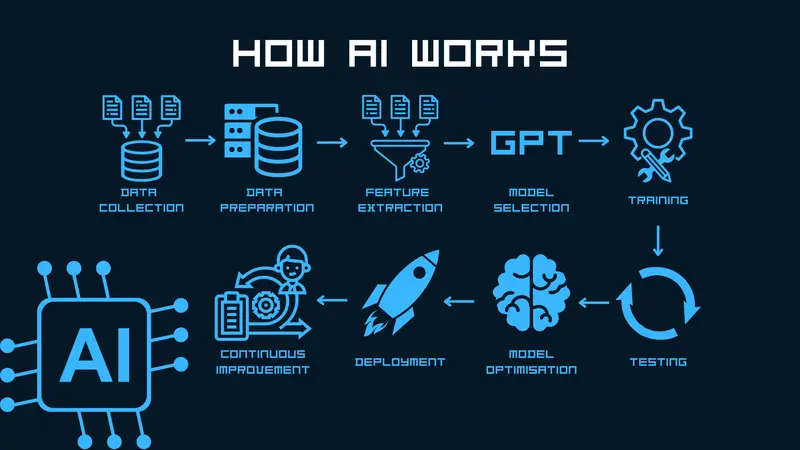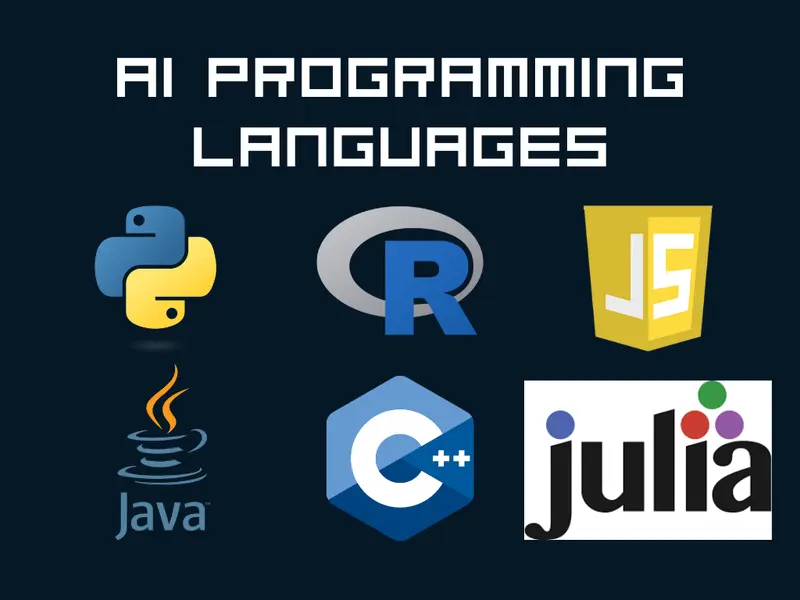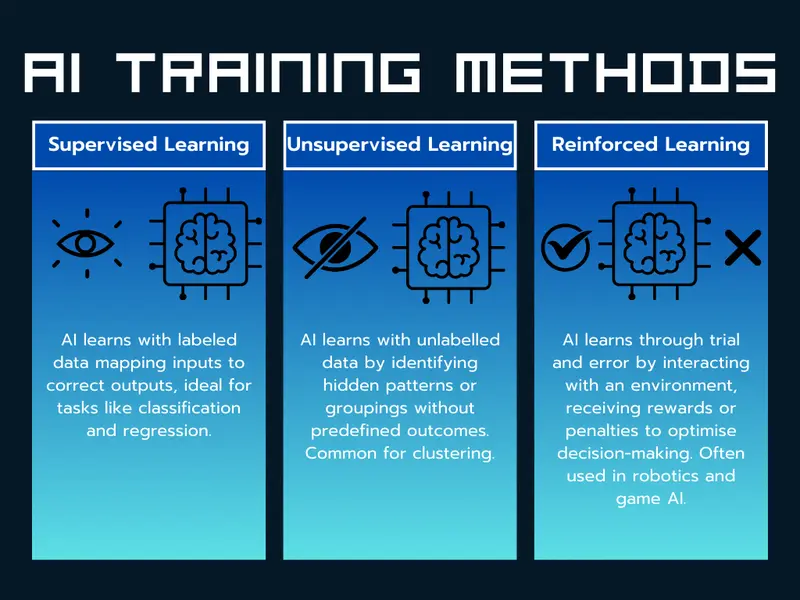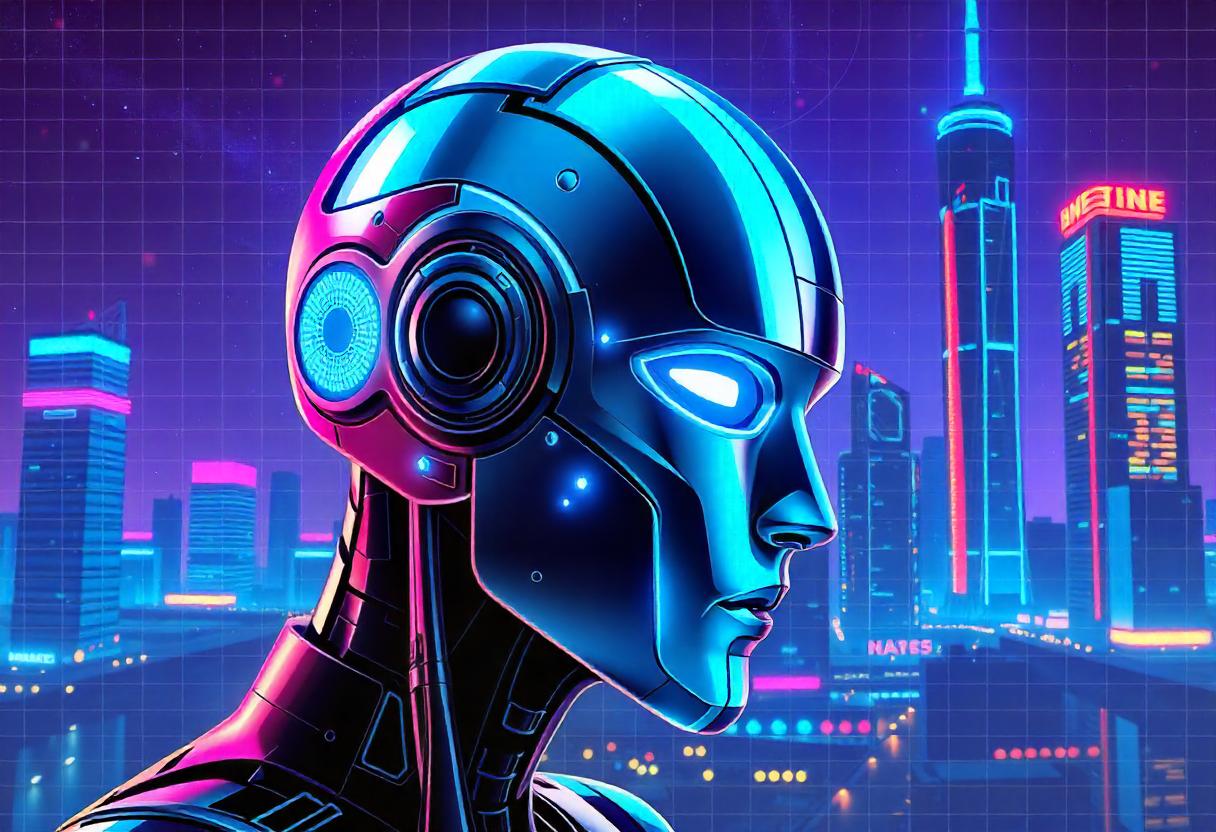How does AI actually work? Whether you are new to this world or want to consolidate your knowledge, this guide will explain the logic behind AI to understand real-world applications, like how Netflix recommends your favourite shows or how ChatGPT is able to answer your biggest questions. Let’s dive in and unravel the magic behind AI!
What is artificial intelligence (AI)?
Very briefly, AI stands for Artificial Intelligence and is the ability of machines and computers to perform tasks that would typically require human intelligence. Think of it like a super-smart assistant that learns from experience and gets better overtime to solve your problems or particular tasks. If you want a more detailed answer, check out our guide on What is AI - The Basics . What is Artificial Intelligence covering the definition of AI, its history, why it's needed, examples and types of AI, and more!
How does AI work step-by-step?

AI systems work through a combination of data, algorithms, and computational power. Here’s a simple step-by-step breakdown:
- Data Collection: AI begins by gathering large volumes of data from various sources like sensors, websites, or user interactions.
- Data Processing: The raw data is cleaned and structured to remove errors or irrelevant information.
- Feature Extraction: Specific patterns or features are identified within the data that are crucial for decision-making.
- Model Selection: A machine learning or AI model is chosen to analyse the data (e.g. neural networks for image recognition).
- Training: The selected model is trained using a subset of the data to learn how to make accurate predictions or decisions.
- Testing: The model is tested on new data to evaluate its performance.
- Model Optimisation: The chosen machine learning or AI model is optimised based on the testing outputs by adjusting the model's neural layers, node updating AI algorithms, or regularising the data.
- Deployment: Once the model achieves satisfactory accuracy, it’s deployed into the real world.
- Continuous Improvement: You are unlikely to get the same response to a specific question if you ask after several days. This is because teams of engineers continuously train their AI models with the new data collected since its deployment to provide more accurate answers.
How is AI programmed?

You cannot directly "program" an AI in the traditional sense of writing step-by-step instructions. Instead, machine learning models are designed and developed for the AI to "learn" from data. These models are developed though programming languages like Python, R, Java, and relevant frameworks to build AI algorithms. The code written enables machines to learn from data, identity patterns, and make decisions to produce an output. Here are key techniques for programming an AI:
- Rule-based Programming: Specific rules are set for the AI to follow.
- Machine Learning (ML): The AI is fed with data to learn patterns instead of relying solely on pre-written rules.
- Deep Learning: Complex neural networks are used to process massive datasets for tasks like speech recognition or image classification.
To learn more about developing an AI, please check out this other blog on List of Programming Languages for AI Development .
How is AI trained?

AI is trained by feeding it vast amounts of data and allowing it to learn by identifying patterns. Here's how:
- Supervised Learning: AI learns from labeled datasets where the correct output is provided (e.g. identifying cats in images).
- Unsupervised Learning: AI analyses unlabelled data to find hidden patterns (e.g. customer segmentation).
- Reinforcement Learning: AI learns through trial and error, receiving rewards for correct decisions and penalties for incorrect ones (e.g. training robots to play games).
The learning process depends on how the data is presented to the AI model and what the actual AI tool is meant to achieve. Hence why different models exist nowadays such as GPT-4o (by OpenAI) excelling in general-purpose tasks, and Claude (by Anthropic) that excels in minimising biased outputs such as clean well-commented code using best practises.
Types of AI
Types of AI vary based on their capabilities or functionalities. For instance, existing types include:
- Narrow AI (Weak AI), a type of AI based on capability, is designed for specific tasks like recommendation systems in Netflix or Spotify.
- Reactive Machine AI, a type of AI based on functionality, focuses on responding to stimuli with predefined actions such as Deep Blue chess computer.
- Limited Memory AI, a type of AI based on functionality, uses historical data to make decisions and improve overtime such as the technology used in self-driving cars or our friend ChatGPT.
There are other four in-development or theoretical types of AI such as General AI (Strong AI), Super AI, Theory of Mind AI, and Self-Aware AI which you can learn more about in Types of AI .
Differences between AI, Machine Learning, Deep Learning, Neural Networks and AI-related Terms
- Artificial Intelligence (AI): The ability of machines or computer systems to simulate human intelligence (e.g. ChatGPT providing human-like responses to user queries).
- Machine Learning (ML): A subset of AI where machines learn from fed data without being explicitly programmed.
- Deep Learning: An advanced form of ML that used neural networks to analyse large datasets (e.g. Netflix learning for your preferences).
- Neural Networks: Inspired by the human brain, these are algorithms designed to recognise patterns and process data in layers.
- Natural Language Processing (NLP): A field of AI that focuses on enabling machines to understand and respond to human language (e.g. chatbots).
- Cognitive Computing: An advanced field of AI that aims to mimic human thought process to solve complex problems (e.g. IBM Watson).
- Computer Vision: The ability of AI to interpret and analyse visual data (e.g. faces, animals, brain images, etc.).
Examples of How AI Works
How does Netflix AI work?
Netflix uses AI to personalise your streaming experience. It works like so:
- Netflix collects data on user behaviour (e.g. viewing history, ratings, search patterns, time on content, etc.).
- Collected data is normalised and key features (e.g. genres, actors) are identified and used to build user profiles.
- Machine Learnings (often deep learning) models are trained on the data to understand your preferences and content relationships.
- The trained model provides more a recommendations.
- The system updates and refines based on new data and user feedback, learning continuously.
How does Google AI work?
Google AI powers search algorithms, maps, and even Google Translate. It works like so:
- Google collects data from search queries, user interactions, scrolling, etc.
- Data is cleaned and normalised to feed to machine and deep learning models to identify patterns and create content relationships.
- Models are tested for accuracy and optimised for performance. Once deployed, these provide real-time predictions or recommendations.
- Google AI continues to improve its models based on user interactions and feedback to adapt to new trends.
How do AI Chatbots work?
AI chatbots like ChatGPT rely on NLP to understand and generate human-like text responses. But how do they provide such answers? Here is how:
- Chatbot collects data from user inputs, queries, intents, and responses.
- Chatbot uses Natural Language Understanding (NLU) to process and understand the user input, identifying intent and keywords.
- Chatbot generates a response based on predefined rules or machine learning models, and makes a decision on the most appropriate answer.
- The AI system manages the conversation flow to maintain context, and uses feedback and new interactions to refine its answers.
